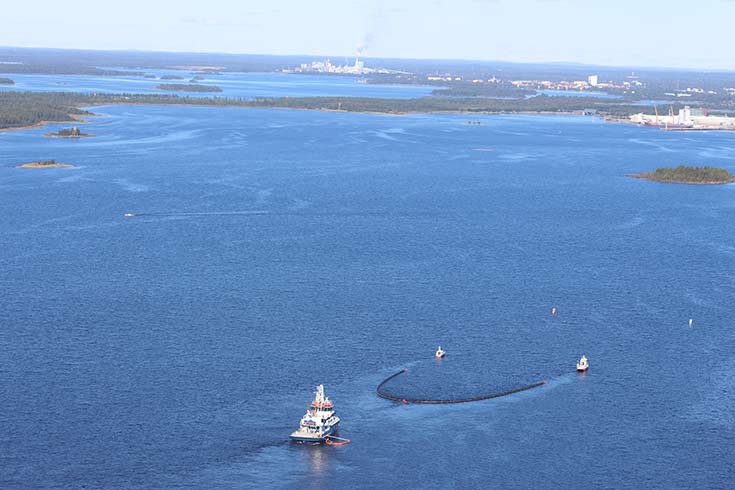Oil spill response exercise: Co-operation between authorities and volunteers
Reita Waara describes how the inclusion of large numbers of volunteers in a large oil spill exercise in the Finnish city of Kemi is so important to future emergency responses of this type.

The authorities practised containing an oil spill in the sea area close to Kemi, using booms. The volunteers also took part in aerial reconnaissance and sorting out oil containment booms (photo: Reita Waara)
More than 150 persons took part in a large oil spill response exercise in the end of August in the city of Kemi, situated in the Bay of Bothnia in northern Finland. The arctic environment and shallow waters in this area pose extra challenges for oil spill response, and smooth co-operation between authorities and volunteer organisations is required for best possible results.
One of the main goals of the exercise was to practise co-operation between authorities and volunteers. The operational model for co-operation created in the project Volunteer Participation in Oil Spill Response co-ordinated by the Finnish National Rescue Association, was tested for the first time in its entirety in Kemi (see CRJ 11:4)
In addition to two local rescue departments, the Finnish Border Guard, police and Kemi Harbour personnel took part in the exercise. Volunteer actors were represented including, among others, the Finnish Lifeboat Institution, Finnish Air Rescue Society, National Defence Training Association and WWF Finland.

The storm Rauli showed its power when rescue department personnel transported volunteers to the nearby island for shoreline clean-up (photo: Ari Soppela Lapland Rescue Department)
The main reason for such large voluntary organisation participation was that before this project, the use of volunteer organisations had not been planned comprehensively and exercised to this extent in major incidents such as in an oil spill response.
“A severe oil spill cannot be managed in the best possible way without the organisations and their trained volunteers,” underlines the leader of the exercise, senior executive fire officer Jyri Keränen from Lapland Rescue Department. Yet volunteers are suited to many tasks in such an emergency, shoreline clean-up to aerial reconnaissance and supporting activities.
The Bay of Bothnia is the northernmost part of the Gulf of Bothnia and also the most northern part of the entire Baltic Sea. Here, local authorities find it important to continue organising oil spill response exercises together with volunteers to keep the regional level of preparedness high, as a vast oil spill would cause irreversible damage to the bay’s environment. The particular characteristics of this bay include small water volume and ice cover during the winter, making it particularly vulnerable to the effects of oil spills. And a severe accident would have immediate effects upon property and the economy.
Reita Waara will be writing a full report on the exercise in the next issue of CRJ (12:2) which is published in December 2016.
Reita Waara, 10/10/2016